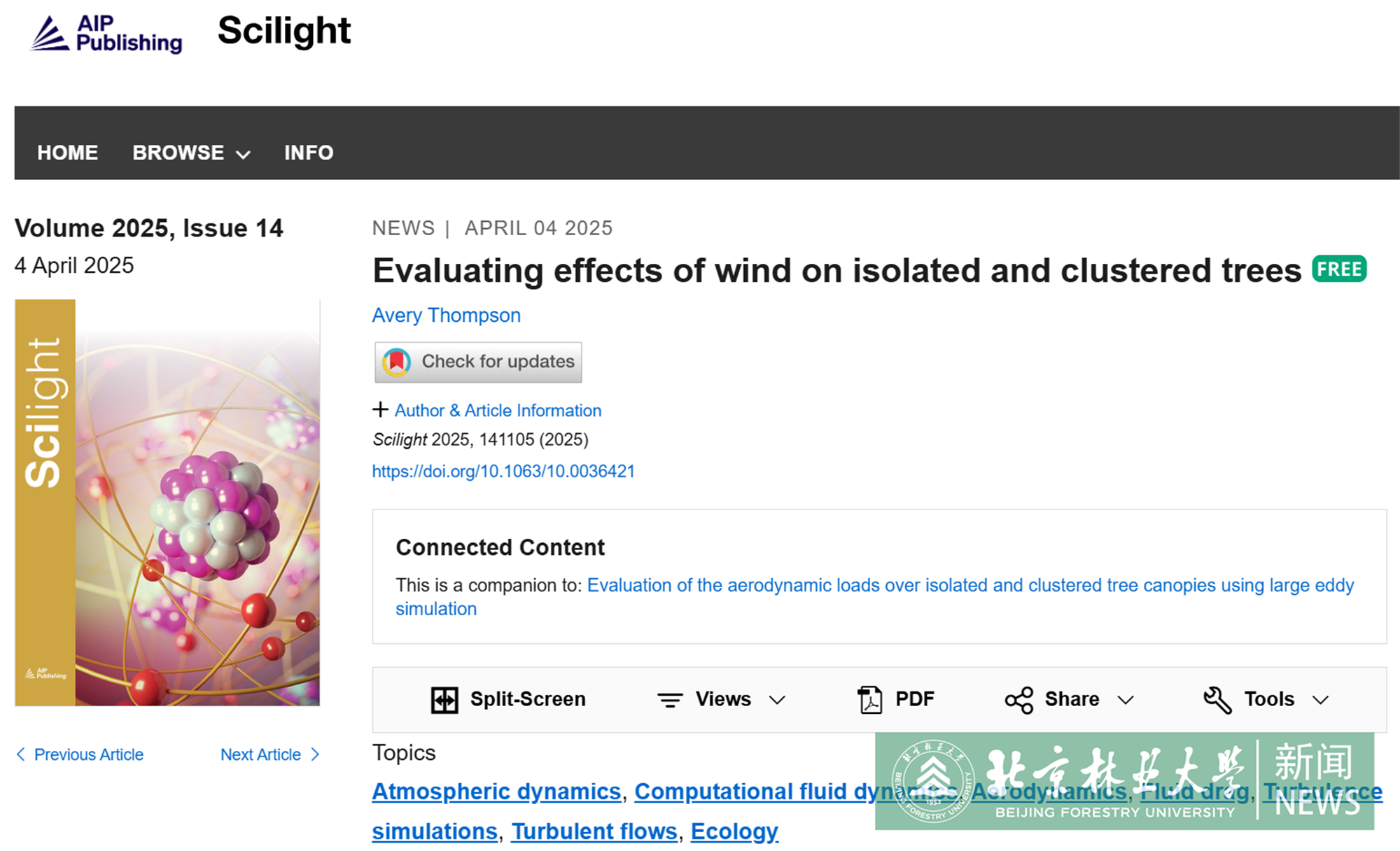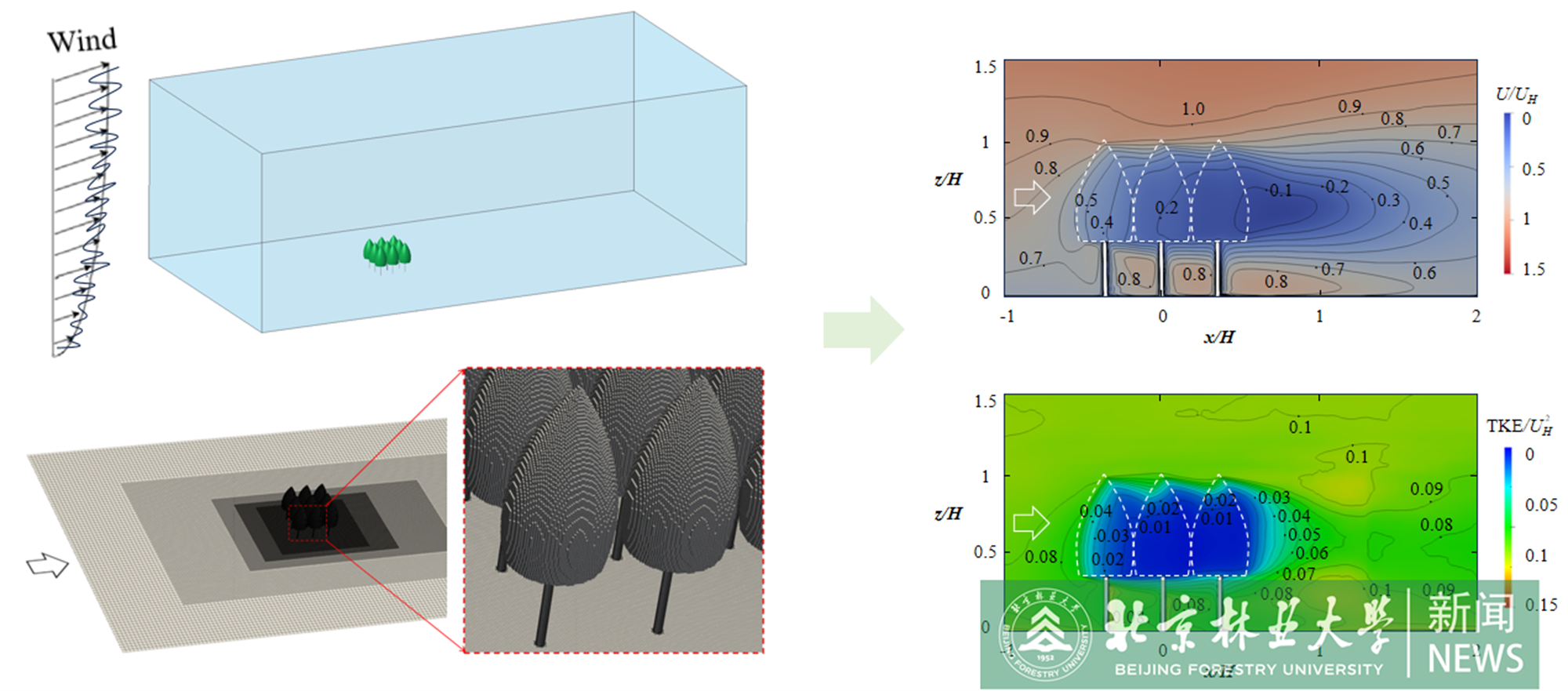Latest news
Research by Dr. Wang Jingxue from Beijing Forestry University's School of Soil and Water Conservation reveals how trees withstand strong winds, gaining international recognition. Published in the leading journal Physics of Fluids, the study, a collaboration with Italy's University of Bologna and China's State Grid research team, was featured on the journal's homepage and highlighted by AIP Scilight, a leading science news platform.

The mechanical resistance of trees is essential for their survival during strong wind events, enabling them to function effectively within an ecosystem. In this study, large eddy simulation is employed to investigate the aerodynamic characteristics of isolated trees with various crown geometries, as well as clustered tree canopies arranged in different patterns and spacing, under both normal and oblique wind directions. For each condition, the aerodynamic force coefficients are evaluated and the underlying flow mechanisms are discussed, also providing a comprehensive characterization of aerodynamic interference effects. As expected, results indicate that the effects of crown width and depth on the aerodynamic force coefficients of an isolated tree are very limited, although larger tree canopies generate stronger shielding effects and, thus, larger wakes. The mean and positive peak overturning moment coefficients of clustered tree canopies generally exhibit an increasing trend with the increase in spacing distance due to the enhanced channeling effects. The mean and positive peak overturning moment coefficients of clustered tree canopies are smaller than those of an isolated tree canopy, with interference factors ranging from 0.15 to 0.98. The corresponding interference factors for an oblique wind direction of 45° are smaller than those of 0°.

AIP Scilight, launched in 2017, reports the most groundbreaking research from over 30 AIP-owned journals, featuring only 300 studies annually worldwide to underscore the most notable research achievements in physics.
Here's what AIP Scilight reported:
Evaluating effects of wind on isolated and clustered trees
In storms and other strong wind events, trees can lose limbs or even be uprooted entirely, potentially causing damage to surrounding structures. Minimizing the damage of falling trees to roads, buildings, and power lines requires understanding the wind limits they can endure.
Wang et al. employed computational fluid dynamics simulations to study the effects of strong winds on both isolated trees and tree clusters. Their simulations can help guide urban planners and forestry managers to create tree arrangements that reduce wind-induced damage.
The researchers simulated the flow field across the canopies of single trees and clusters of different spacing and arrangement. They then calculated the overturning moment coefficients — a reflection of the amount of toppling force experienced — for each tree.
"The overturning moment coefficients of clustered tree canopies are smaller than those of an isolated tree canopy, primarily due to shielding effects, with the largest reduction of 85%," said author Jingxue Wang. "The corresponding values generally exhibit an increasing trend with the increase in spacing distance between trees due to enhanced channeling effects."
Furthermore, trees placed in a staggered pattern may exhibit higher overturning moment coefficients than trees in straight rows, due to the lack of shielding from trees in front.
The authors plan to continue to develop their model by introducing more real-world variables, making their data relevant to even more situations.
"The current studies mainly focus on the trees on flat terrain. The next-step study will shift its focus to the aerodynamics of trees in complex terrains, such as mountainous regions," said Wang.
Source: "Evaluation of the aerodynamic loads over isolated and clustered tree canopies using large eddy simulation," by Jingxue Wang, Luca Patruno, Haiyang Wang, Ping Wang, and Danyu Li, Physics of Fluids (2025). The article can be accessed at https://doi.org/10.1063/5.0256171.
Paper link:https://doi.org/10.1063/5.0256171
AIP Scilight report:https://doi.org/10.1063/10.0036421
作者:王京学;审稿:高广磊 | 编辑:杨一楠; 审核:杨金融












